| | | 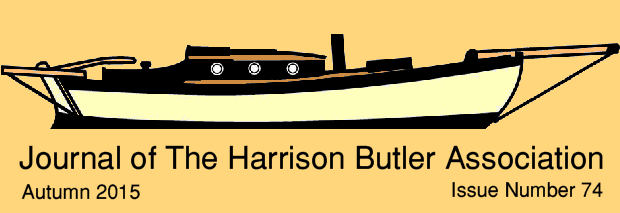
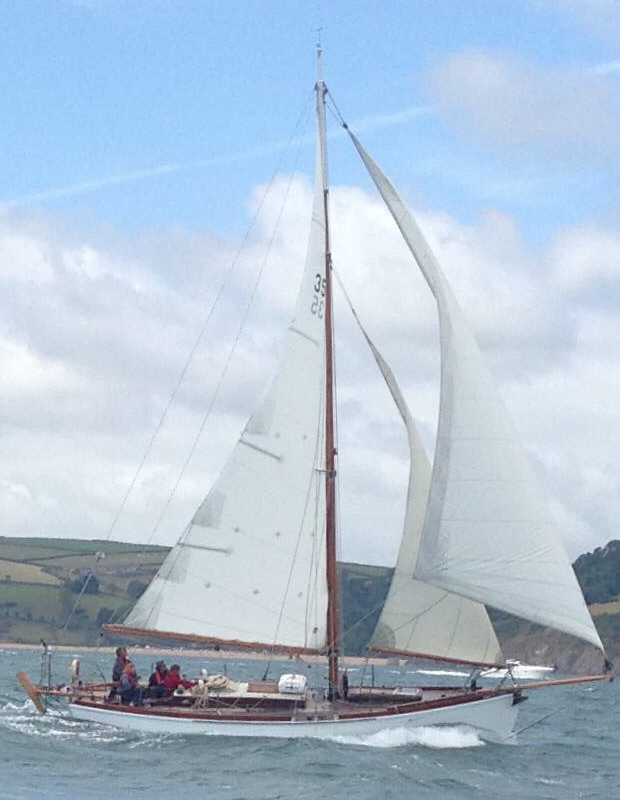
The Dartmouth Classics Regatta 2015; Mat Ali racing along in a Force 5.
She's owned by Charles Hussey & Mary Watson.
Photograph taken by Jonathan Brooking from aboard Lindy II.
The Journal of The Harrison Butler Association
Editor : Martin Hansen
Proof Reading : Dr Helen Jones
Far East Correspondent : Dr Stephen Davies
Australian Correspondent : David Stamp
Netherlands Correspondent : Michiel Scholtes
Baltic Correspondent : Myriam Spicka
UK Correspondent for The Solent : Robert Griffiths
UK Correspondent for Dartmouth : Allen Clarke
Contributions for the Journal are most welcome be they
fully formed articles, rough notes or snippets of News.
If you feel you would like to contribute on a regular basis,
applications to join our growing network
of correspondents are also invited.

As an experiment, I've opened up a new section on the website for “Invited Friends of the HBA”. The idea behind this is to explore there being a place for appropriate boats that are not designed by Harrison Butler, but which belong to Full Members of the Association or their friends. It would be a perk of Full Membership that the friend of a Full Member could be invited to join as an Associate Member, and that the friend's boat could then be added to the “Invited Friends of the HBA” section of the website.
As a first example of this proposal in action, I've added our Honorary Treasurer's lovely 1910 wooden sailing boat, Cautious Clara, to the Friends section of the website. Peter's given the HBA sterling service over many years, and his endeavours and experience in restoring Cautious Clara dovetail seemlessly with what many owners of Harrison Butler designed boats are also grappling with. He's a good man with an enchanting boat, worthy of having a page on our website.
As a second example, I've invited Simone Mancini and her boat Kara Third to be a friend of the HBA. Simone contacted the Association having just bought Kara Third and believing her purchase to be a boat built to a published Harrison Butler design. However, our authentication officer, Paul Leinthall-Cowman, ruled that the builder had deviated too far from the official version of the design for Kara Third to be accepted as bonefide Harrison Butler. Yet she is seeking help and advice from the owners of similar boats, and the camaraderie amongst like-minded souls for which the HBA community is famous. Simone has such an enthusiasm and passion for what we are about, that it seems wrong to be refusing to connect.
An attraction of this endeavour to open out the Association and widen its outlook is that it is under the control of the Full Members; those who own or have owned an authenticated Harrison Butler designed boat. If members don't invite friends, nothing will come of the initiative. It also gives a tangible new benefit to being a fully paid up member of the HBA. Now you can invite your friends aboard !

!•¡•! The 5th Edition of Harrison Butler's inspirational work Cruising Yachts: Design and Performance is due to be published on October 9th by Lodestar Books. There are up to date photographs of several boats alongside the classic text.
!•¡•! The long established South Coast Laying Up Supper is again upon us on the 10th and 11th of October. Robert Griffiths and Peter Cook have sent out invitations; last minute additions to r-a.griffiths@tiscali.co.uk
!•¡•! Far fewer boats are for sale this quarter. Two confirmed recent sales are June (asking price £3,500) and Zenocrate (asking price £5,950). For various reasons, four other boats are no longer being advertised; Tamaroa, Watermaiden, Zebedee, and Zephon. My pick for an end of season bargain would be Chiquita, provided you're willing and able to do some work on her hull.
From Chichester to Dartmouth
~ Our Purchase and First Sail in Diana ~
Kate Jennings & Allen Clarke
The HBA's UK Correspondents for Dartmouth
We initiated our purchase of Diana because of a desire to recapture the joy of small boat sailing. The hope, for us, is that she will herald a return to basics without the cost and time consumed by having to sort out the systems associated with larger Hi-Tech boats. To give you some idea of just how basic we are aspiring to be, when we were asked if we wanted to reinstate her porta potta, removed but kept by a previous owner, we politely declined. Kate and I prefer a simple bucket on a boat this small ! (Your head is never going to be far enough away from the heads otherwise. A bucket you can put outside) And we liked that she came with an old, but straightforward and reliable, SeaTalk echo sounder backed up with a leadline !
Before we could finalise our purchase a few issues needed resolving. For a few years her maintenance had been entrusted to a group of boat builders who routinely reassured the previous owners that the boat was in a serviceable condition. She was being sold as such. It turned out, however, that the coach roof coaming was as mushy as a rotten pear and the engine heat exchanger shot. However, Kate and I refused to have negative thoughts about Diana and patiently waited whilst the yard in Emsworth sorted her out. There is a rich history with Diana and, though we looked at several other good boats before settling on her, we both knew when we stepped on board that here was something special.
The purchase completed, Kate and I sailed Diana from Emsworth Yacht Harbour to her new mooring on the River Dart. We decided to make it a nonstop trip to make good use of two days worth of forecast easterlies. Our passage took us around the back of the Isle of Wight with a lumpy sea of St Katherine's and strong gusts in the squalls off Poole bay at night. Forked lightning was all around us, and with following seas we managed to get her surfing on the bigger waves. Not bad for a 19 foot waterline boat weighing 3 and a 1/4 ton. We took a conservative approach to sailing Diana and reefed early, then staying with the second reef in the main and a heavily furled jib until dawn. We were then well past Portland Bill. The last half of our crossing of Lyme bay was against the current. With the breeze dropping off we motor sailed the last four hours to the Dart.
Six miles off the Dart we were greeted with a school of common Dolphins, perhaps forty or so, and a few of them came to play around Diana, as they do. Our total trip time was 26 hours, mooring to mooring. Diana held together and even her ancient tan sails lasted, just, though the jib had to have a few running repairs to the clew in the night to prevent the whole thing pulling away. Thank goodness for self-adhesive sail repair tape. The biggest lesson we learnt from this little trip is don't leave without your spare diesel. The fuel cans were in the boot of the car at Emsworth Yacht Harbour and put paid to my 'just in case' plan of topping up the fuel tanks for the last few miles. We did manage to siphon off enough reasonably clean fuel from the contaminated starboard fuel tank to give us enough in the port tank (the only useable one at the moment).
Kate and I have been in touch with two of Diana's previous owners, John Flouter & Greg Skelton, and have a mass of info from them and a load of design sketches from when they restored her back in the late eighties and early nineties. Greg has some video files from his time sailing her that we hope to see at some point along with old pictures. Particularly prized are copies of a letter written by THB about his thoughts on sailing her, an article by the builder, and letters from other previous owners. All good stuff that is adding to the pleasure we are deriving from taking on this perfectly formed little yacht !
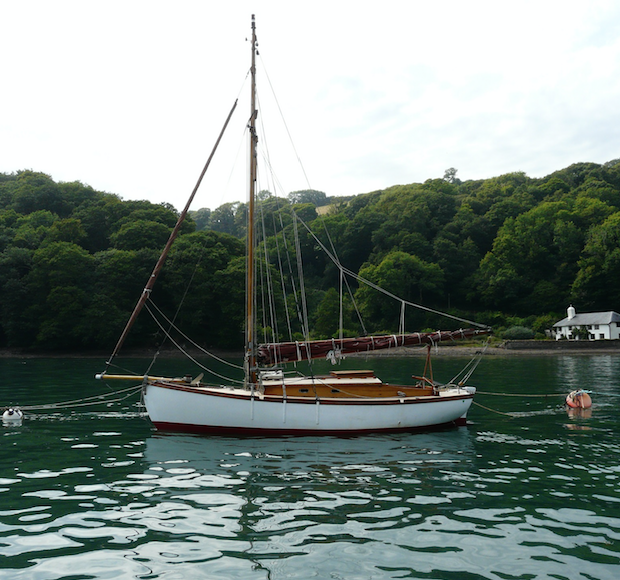
Diana on her new mooring on the river Dart, August 2015
New Nature
Michiel Scholtes
The HBA's Netherlands Correspondent
In the 19th century many painters of Dutch landscapes refused to disclose the locations where they worked for fear of causing crowds of curious onlookers to visit, so spoiling their beauty. These painters came into my mind when I sailed Eenhoorn across the cool but sunbathed IJmeer towards the UItdammerdijk. A sailing friend had been less secretive: “It's a real miracle, an enclosed stretch of water between the old dyke and the newly created nature reserve. And, you know, it's quite deep - for the keel of your little ship that is”.
The entrance was not easy to find. I guided Eenhoorn parallel to a low and aged dyke of weathered grey stones, spotted with bright yellow moss, with fresh green willows waving to and fro in the breeze above. Where was the hole in this wall that my sailing friend had recommended I find ? A transit of two distant church spires under a high blue heaven suggested I was getting close. Even so, only when quarter a mile off could I distinguish the passageway to the secluded, secret waters beyond the long and otherwise unbroken stone barrier.
When I tacked to avoid a small traditional fishing vessel at anchor, the air above filled with life. Hundreds of terns and thousands of screaming black faced gulls rose into the sky. Close hauled on the port tack, Eenhoorn sailed towards the dyke under mainsail and jib, and, without fear, straight through the narrow gap. Briefly, I wondered if my sailing friend was right about the depth. Again I tacked to keep to where the water was likely to be deepest. The sails flogged in the wind as Eenhoorn came about, the noise causing another cloud of airborne birds; they were not used to a yacht sailing through their domain.
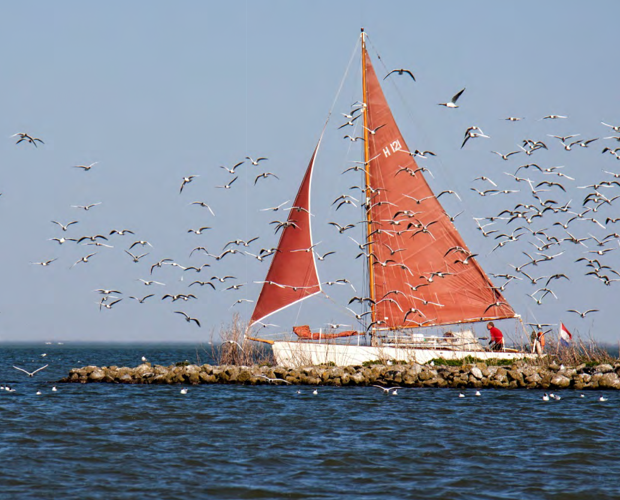
On the starboard tack I sailed along a glittering ribbon of still water, closing steadily on a lee shore of stoney banks interspersed with tiny beaches where scrubs and reeds grew and innumerable waterbirds busily bustled about. Here and there waves had created little ponds and lagoons where oyster catchers picked for food and nile geese jealously guarded their young. Ducks and swans abounded. A single cormorant stuck his reptile like head from the water surface. I'd read that spoonbills have nests where this band of water has nature reserve status and that last winter some flamingos sought refuge here from the cold.
Ahead, a yellow-red beacon floated on the water; the beginning of the nature reserve, compensation for the nature lost when IJburg, the latest eastward expansion of Amsterdam, was laid out. It was the sign to not sail any further. I turned Eenhoorn into the wind and, as she lost way, dropped jib, main, anchor and ten meters of chain. Then there was peace. Nothing but the casual honking of geese, the sharp 'kree kree' of terns as they dived for little fish around my anchorage, and the occasional turmoil of excited gulls at the entrance, ever in territorial strife. I inflated the tender and rowed to the old dyke. Upon its ridge the wind doubled in strength. The landscape doubled too as the watery expanse of the IJmeer on one side found its dry and lower mirror image on the other; where the green grassy polders of Waterland ran all the way to the horizon. Birdlife too suddenly came in two varieties: the sound of waterbirds on the water mingled with those of land birds that nested in the meadows below. Listening, I could identify lapwings, godwits and redshanks.
A crow pulled at a dead branch. Sparrows noisily fussed about the leftovers of a hay bale where sheep had been fed. A tractor rattled in the distance. The nearness of Amsterdam was unsettling: I could easily identify the modern skyscrapers at Omval and Zuidas, and the many new buildings along the IJburg. I was surprised at how this Waterland could be so seemingly untouched by the proximity of such urbanity.
Later that afternoon I weighed anchor and glided Eenhoorn back out to sea. The wake of gulls slowly became indistinct in a haze of warm sunlight as I gazed astern in lingering delight. Maybe such newly created nature is not “real nature” as some critics have said. However, as far as I am concerned a hundred more spots of “new nature” like this would transform the dull dykes of IJmeer, Markermeer and IJsselmeer into paradise. A small strip off the main dyke, a band of still water between, the one half a reserve, the other half for dropping your anchor: what else is needed for happiness ?
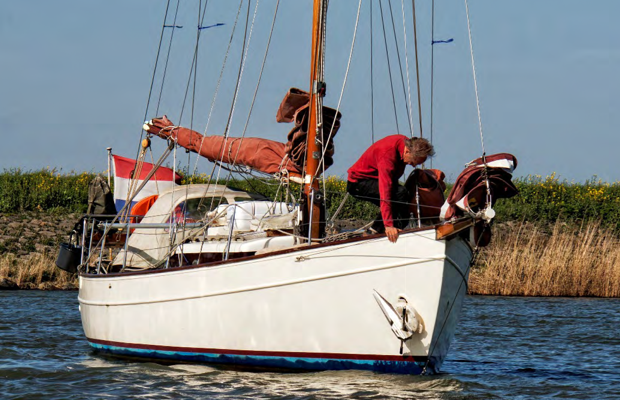
Michiel Scholtes aboard Eenhoorn.
She's one of a number of boats inspired by Harrison Butler's designs but built in steel.
Eenhoorn features several modifications to take advantage of
the design being implemented in metal, such as the through hull anchor.
Plymouth Classic Boat Rally 2014
From Tramontana's Log
2014 : July : 25th : Friday
Today was spent making Tramontana presentable as an attraction in the Plymouth Classic Boat Rally 2014. I replaced corroded screws on the folding companionway door and made two information boards so visitors could read about Tramontana's history and current voyage along the English Channel from Ipswich to Cardiff. I hoisted signal flags that spelt out “Plymouth is ace” although I suspect that nobody noticed; there were thousands of flags being worn that day!

Tramontana's Signal Flags at The Plymouth Classic Boat Rally 2014
They spell out “Plymouth is ace”
( Chosen so that the same letter does not appear more than once ! )

South Coast Summer Rally 2015
~ The June Gathering in Bembridge ~
Robert Griffiths
The HBA's UK Correspondent for The Solent
Five boats made it to Bembridge on the morning of June 13th for this year's summer meet. Destina and Sabrina arrived first from the West having made good time in the prevailing force 5/6 WSW and Mischief III, Vindilis and Lindy II were later arrivals after having had to beat from Chichester Harbour in the East.
The day was spent with ice creams and dog walking on the grass and heath of the St Helen's Duver (a colloquial Isle of Wight term pronounced “dover” for the sand spit and dunes that protect Bembridge Harbour from the sea) and in retail therapy and walks around Bembridge headland, for those that crossed the harbour to the Bembridge side. This included the procuring of lobsters and prawns from the local fisherman's pontoon that became part of the culinary delights consumed during the evening pontoon party, that doubled as a birthday party for Craig Nutter (Sabrina).
The following day was less windy. Requirements of the tide necessitated the Chichester craft depart early in the morning whereas those returning west were able to take a more leisurely return passage: after they had completed the clear up from the previous evening.
The next South Coast meet will be the rally combined with the laying up supper at Gins (River Hamble) on October 10th and 11th; where we hope those of you unable to come by boat will join us for the meal.
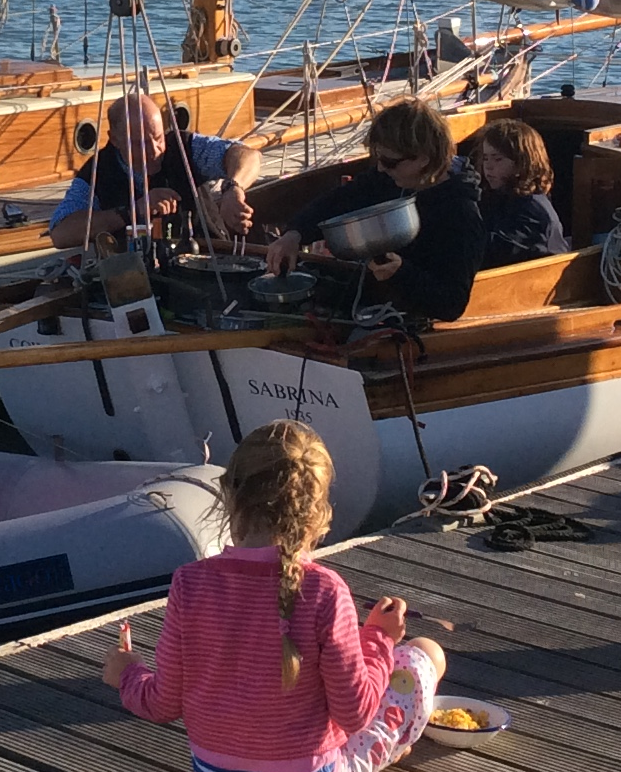
The South Coast Meet 2015's pontoon party at Bembridge, IoW.
Zyclon, My Boat
Part I
Peter Vandenhirtz
Aged 32, full of sailing dreams, I began my first serious sea voyage - a passage from Nieuwpoort in Belgium, west along the length of the English Channel, and into Falmouth. This was in a well regarded and capable plastic boat I owned, a Shipman 28. Immediately taken with the beauty of this English seafaring port, and somewhat shaken by the rough reality of life on the ocean waves, I stopped thinking of sailing on to the Caribbean, in retrospect, a somewhat unrealistic dream for me at that time, and decided instead to explore this lovely land of sea and boats.
Looking around boat yards is one of life's pleasures and, although I already owned a boat, this didn't stop me from exploring those around the Fal estuary. In one, near Mylor, I spied a shabby looking small wooden boat for sale under a spotty green canvas cover. It had obviously been standing there for a long time. Her beautiful lines lured me back the next day for a closer look. I made an offer of half the asking price, not expecting it to be accepted, but it was, and - Bang ! - less than a month after my arrival at Falmouth, Zyclon was mine. Wow !
A wooden boat, well maintained, is a thing of beauty. When I bought her, in May 1994, Zyclon had been ashore for eleven years. During the last two of those, an optimistic dreamer with big plans had stripped her interior but then abandoned the project when it came to putting it all back together again. In the chaos a keel bolt had been lost. Under the cabin step was a huge two cylinder Albin petrol engine. It wasn't seized but it didn't run either. I may have given up on the Caribbean, but I had plenty to do.
When starting on a seemingly hopeless project, one must be completely in love with it. For me, that meant making Zyclon look nice, to make the endeavour feel worthwhile. I started with the least important task: the bright work - I was soon able to marvel at how it gleamed ! I removed all of the old, breaking up varnish, and replaced it with the D1/D2 oil system. That took three weeks with a heat gun, chemical paint stripper, scraper, wire brush and sand paper. Once finished, she looked so gorgeous that I decided, for the first time, to leave off her old tarpauline for the night. That night it rained heavily. Everything inside got soaked ! So much for my belief that oil would tighten and weatherproof a nailed teak-over-pine deck. I was to spend the next two years living under that spotty green canvas cover...
Eventually, as summer ended, Zyclon was ready to be reintroduced to the sea. Having smeared putty into the seams, she didn't take in much water. The engine was now useable although temperamental. Once afloat, the mast was stepped but I lost a washboard overboard when trying to sort out the rigging. I moved house: the Shipman went ashore and was put up for sale and Zyclon went into Falmouth Marina for the winter. With two boats to maintain, my bank account was depleted. Christmas was spent with my family in Belgium and I worked as barman for a few weeks in my sisters café, earning badly needed cash.
To be continued...
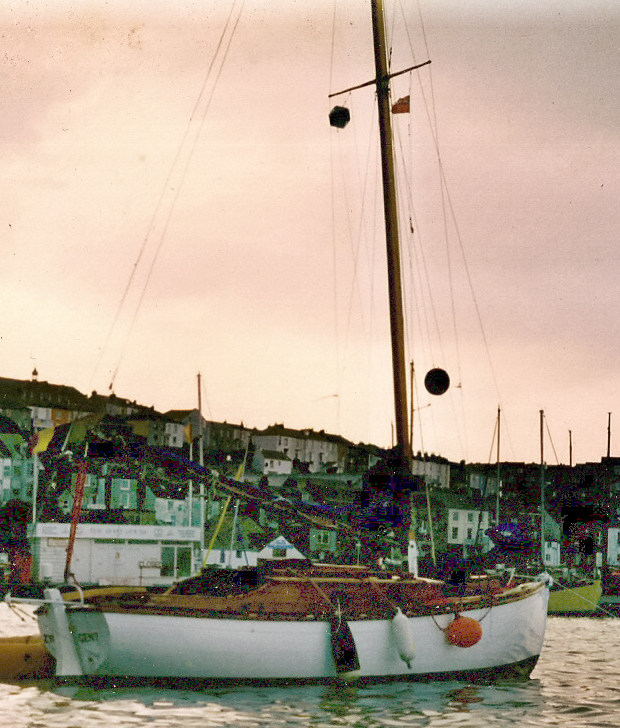 Zyclon, wearing the flag of Belgium, and Red Ensign as courtesy flag, in Falmouth, 1996. Zyclon, wearing the flag of Belgium, and Red Ensign as courtesy flag, in Falmouth, 1996.

Chiquita : Z4 : 1939 : Devon, UK : £1,500
Cyclone : Cyclone Design : 1941 : Netherlands : £11,000
Jane : Bogle Design : 1939 : Cornwall, UK : £10,000
Jolanda : Omega Design : 1996 : Germany : £25,000
La Bonne : Nursery Class : 1919 : Devon, UK : £POA
Saltwind : Z4 : 1940 : Spain : £16,000
Senorita : Cyclone II Design : 1934 : New Zealand : £4,000
Thule : Yonne Design : 1934 : Netherlands : £15,000 -£18,000
Witte Walvis : Z4 : 1939 : Netherlands : £5,000
Amiri's Tiller Immobilizing Lashing
David Stamp
The HBA's Australian Correspondent
The photograph shows the way in which we lash the tiller when Amiri is moored, and we do not want to have any wear-inducing movement between the rudder pintles and gudgeons. Rather than fix the tiller with a clove hitch, which can permit the tiller to roll to and fro within the clove hitch, we complicate matters a little, but very quickly, to bring the line of pull of the lines to the centre of the tiller, so that it is held firmly and unable to move.
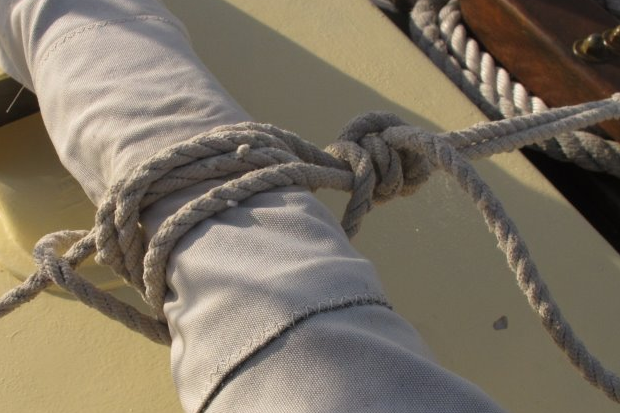
Here is a sketch, very quickly dashed off, which may be of help if you would like to try this knot out. It can take the place of a time knot, which usually takes about two hours to undo...
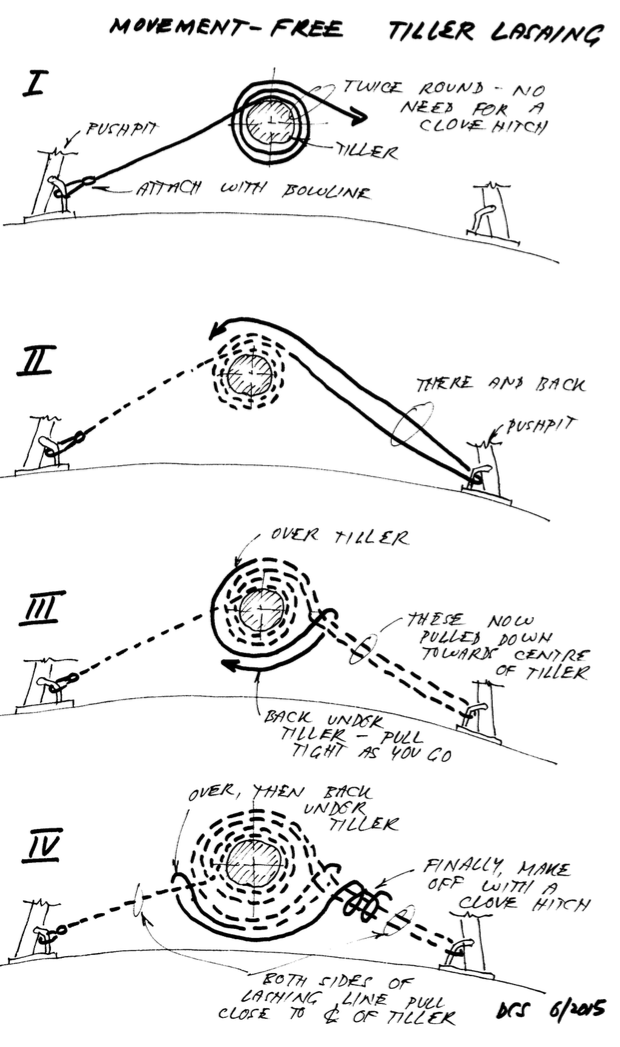

| |